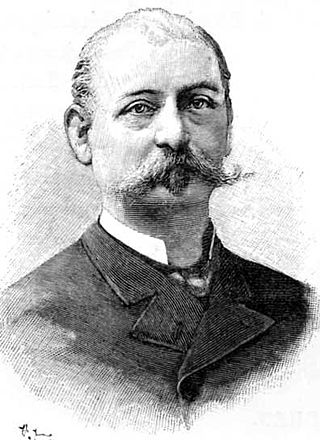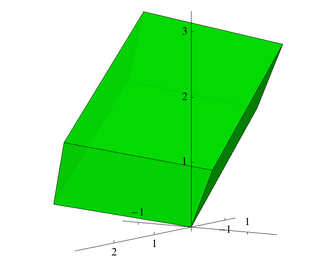
In mathematics, a Diophantine equation is an equation, typically a polynomial equation in two or more unknowns with integer coefficients, for which only integer solutions are of interest. A linear Diophantine equation equates to a constant the sum of two or more monomials, each of degree one. An exponential Diophantine equation is one in which unknowns can appear in exponents.
In complex analysis, a branch of mathematics, the Casorati–Weierstrass theorem describes the behaviour of holomorphic functions near their essential singularities. It is named for Karl Theodor Wilhelm Weierstrass and Felice Casorati. In Russian literature it is called Sokhotski's theorem, because discovered independelty by Sokhotski in 1868.

In mathematics, a quintic function is a function of the form

In transcendental number theory, the Lindemann–Weierstrass theorem is a result that is very useful in establishing the transcendence of numbers. It states the following:
In geometry, a hypersurface is a generalization of the concepts of hyperplane, plane curve, and surface. A hypersurface is a manifold or an algebraic variety of dimension n − 1, which is embedded in an ambient space of dimension n, generally a Euclidean space, an affine space or a projective space. Hypersurfaces share, with surfaces in a three-dimensional space, the property of being defined by a single implicit equation, at least locally, and sometimes globally.
In mathematics, the Lagrange reversion theorem gives series or formal power series expansions of certain implicitly defined functions; indeed, of compositions with such functions.

Georges-Henri Halphen was a French mathematician. He was known for his work in geometry, particularly in enumerative geometry and the singularity theory of algebraic curves, in algebraic geometry. He also worked on invariant theory and projective differential geometry.
In measure theory, an area of mathematics, Egorov's theorem establishes a condition for the uniform convergence of a pointwise convergent sequence of measurable functions. It is also named Severini–Egoroff theorem or Severini–Egorov theorem, after Carlo Severini, an Italian mathematician, and Dmitri Egorov, a Russian mathematician and geometer, who published independent proofs respectively in 1910 and 1911.
In mathematics, the Riesz–Fischer theorem in real analysis is any of a number of closely related results concerning the properties of the space L2 of square integrable functions. The theorem was proven independently in 1907 by Frigyes Riesz and Ernst Sigismund Fischer.
In semi-Riemannian geometry, the Bel decomposition, taken with respect to a specific timelike congruence, is a way of breaking up the Riemann tensor of a pseudo-Riemannian manifold into lower order tensors with properties similar to the electric field and magnetic field. Such a decomposition was partially described by Alphonse Matte in 1953 and by Lluis Bel in 1958.
In mathematics, Serre's modularity conjecture, introduced by Jean-Pierre Serre, states that an odd, irreducible, two-dimensional Galois representation over a finite field arises from a modular form. A stronger version of this conjecture specifies the weight and level of the modular form. The conjecture in the level 1 case was proved by Chandrashekhar Khare in 2005, and a proof of the full conjecture was completed jointly by Khare and Jean-Pierre Wintenberger in 2008.

In mathematics, the discriminant of an algebraic number field is a numerical invariant that, loosely speaking, measures the size of the algebraic number field. More specifically, it is proportional to the squared volume of the fundamental domain of the ring of integers, and it regulates which primes are ramified.
In mathematics, a CR manifold, or Cauchy–Riemann manifold, is a differentiable manifold together with a geometric structure modeled on that of a real hypersurface in a complex vector space, or more generally modeled on an edge of a wedge.
In mathematical analysis, Korn's inequality is an inequality concerning the gradient of a vector field that generalizes the following classical theorem: if the gradient of a vector field is skew-symmetric at every point, then the gradient must be equal to a constant skew-symmetric matrix. Korn's theorem is a quantitative version of this statement, which intuitively says that if the gradient of a vector field is on average not far from the space of skew-symmetric matrices, then the gradient must not be far from a particular skew-symmetric matrix. The statement that Korn's inequality generalizes thus arises as a special case of rigidity.

In number theory, Fermat's Last Theorem states that no three positive integers a, b, and c satisfy the equation an + bn = cn for any integer value of n greater than 2. The cases n = 1 and n = 2 have been known since antiquity to have infinitely many solutions.
Relativistic heat conduction refers to the modelling of heat conduction in a way compatible with special relativity. In special relativity, the usual heat equation for non-relativistic heat conduction must be modified, as it leads to faster-than-light signal propagation. Relativistic heat conduction, therefore, encompasses a set of models for heat propagation in continuous media that are consistent with relativistic causality, namely the principle that an effect must be within the light-cone associated to its cause. Any reasonable relativistic model for heat conduction must also be stable, in the sense that differences in temperature propagate both slower than light and are damped over time.
In mathematics, Thomae's formula is a formula introduced by Carl Johannes Thomae relating theta constants to the branch points of a hyperelliptic curve.
In mathematics, the Cauchy–Kovalevskaya theorem is the main local existence and uniqueness theorem for analytic partial differential equations associated with Cauchy initial value problems. A special case was proven by Augustin Cauchy, and the full result by Sofya Kovalevskaya.
Laver's theorem, in order theory, states that order embeddability of countable total orders is a well-quasi-ordering. That is, for every infinite sequence of totally-ordered countable sets, there exists an order embedding from an earlier member of the sequence to a later member. This result was previously known as Fraïssé's conjecture, after Roland Fraïssé, who conjectured it in 1948; Richard Laver proved the conjecture in 1971. More generally, Laver proved the same result for order embeddings of countable unions of scattered orders.
Frédéric Ladislas Joseph Marty was a French mathematician.











